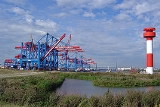
Container Terminal Altenwerder
Encyclopedia

Hamburg
-History:The first historic name for the city was, according to Claudius Ptolemy's reports, Treva.But the city takes its modern name, Hamburg, from the first permanent building on the site, a castle whose construction was ordered by the Emperor Charlemagne in AD 808...
, Germany
Germany
Germany , officially the Federal Republic of Germany , is a federal parliamentary republic in Europe. The country consists of 16 states while the capital and largest city is Berlin. Germany covers an area of 357,021 km2 and has a largely temperate seasonal climate...
currently is one of the most modern container
Intermodal freight transport
Intermodal freight transport involves the transportation of freight in an intermodal container or vehicle, using multiple modes of transportation , without any handling of the freight itself when changing modes. The method reduces cargo handling, and so improves security, reduces damages and...
terminals in the world, located in the Altenwerder
Altenwerder
Altenwerder is a quarter in the Harburg borough of the Free and Hanseatic city of Hamburg in northern Germany. In the 1970s the city of Hamburg announced the formal dispossession of all property to build the Container Terminal Altenwerder. The terminal started its operation in 2003. Altenwerder is...
quarter. It is owned by the Hamburger Hafen und Logistik AG
HHLA
Hamburger Hafen und Logistik AG is a German logistics and transportation company. The firm operates three container terminals at the Port of Hamburg: Altenwerder, Burchardkai and Tollerort, as well as cargo handling and transport services by rail, road and sea...
(HHLA) (74.9%) and Hapag-LLoyd
Hapag-Lloyd
Hapag-Lloyd is a German transportation company comprising a cargo container shipping line, Hapag-Lloyd AG, which in turn owns other subsidiaries such as Hapag-Lloyd Ships and a cruise line, Hapag-Lloyd Cruises which is now integrated into TUI AG, Hanover...
AG shipping lines (25.1%) and lies to the south of Hamburg on the river Elbe
Elbe
The Elbe is one of the major rivers of Central Europe. It rises in the Krkonoše Mountains of the northwestern Czech Republic before traversing much of Bohemia , then Germany and flowing into the North Sea at Cuxhaven, 110 km northwest of Hamburg...
.
The terminal, opened in year 2001, spreads on a surface of 983500 square metres (1,176,256 sq yd) and has the capacity of approx. 3 Mill. TEU annually. Right now, 2.4 Millions TEU capacity is used.
With 1400 metres (4,593 ft) long quay wall of the CTA is enough to load and empty up to four container ships, including larger ships of the next generation. Maximum draught is 16.7 metres (55 ft), where the quay wall has a height of 7.5 metres (25 ft) over NN (Above mean sea level). With 12 millions M3 sand heaped up, a height difference between dock edge and base of the Elbe river of 24 metres (79 ft) created.
The centric container area with a capacity of 30.000 TEU takes the largest part of the surface with connections for cooltainers. The area is served by 22 pairs of cranes and 53 vehicles. The characteristic of the terminal is the nearly fully automated operational sequence.
The way of a container in the CTA
The ship sets on one of the four couch places. One of the 14 two-Katz container bridges takes care of the container. First the crane driver in the main cat transports it on the lax platform of the bridge, where lax worker removes TwistlockTwistlock
A twistlock and corner casting together form a standardised rotating connector for securing shipping containers. The primary uses are for locking a container into place on container ship, semi-trailer truck or railway container train; and for lifting of the containers by container cranes and...
s. In the port, the fully automatic handling begins. As soon as one of the 65 AGVs on the land side of the bridge automated themselves, the portal cat reloads the container. The driverless AGV finds its way to the destination conveyed by radio waves and moreover it is being watched by GPS. The pedestrian access to the area of AGV drive is prohibited for security reasons.
The AGV parks in front of one of the 26 camp blocks, where a pair of gantry cranes (double Rail Mounted Gantry - DRMG) unloads the container for temporary storage. Each block covers 10 rows of 37 TEU places, at each place can four - in the external rows five - containers be stacked. The DRMG consists of two independent cranes, so that the sea-side with the AGV and the opposite side with the trucks can be served simultaneously. Due to their different sizes, two cranes can work simultaneously over the entire block, the smaller crane drives simply under the larger one.
On the back of the camp there are 4 tracks for trucks and 6700 metres (21,982 ft) long railway. The container is loaded from the DRMG on the chassis of the truck. This procedure is remote controlled.
If the container is to be carried on by truck, it remains on the chassis. In the case of a rail transport, it is led to the station. It is loaded there by one of the three manual rail cranes on the train. The drivers of the trucks receive their driving orders from radio data transmission terminals within the CTA.
Before leaving the port, the railway or the road, another tariff control takes place.

